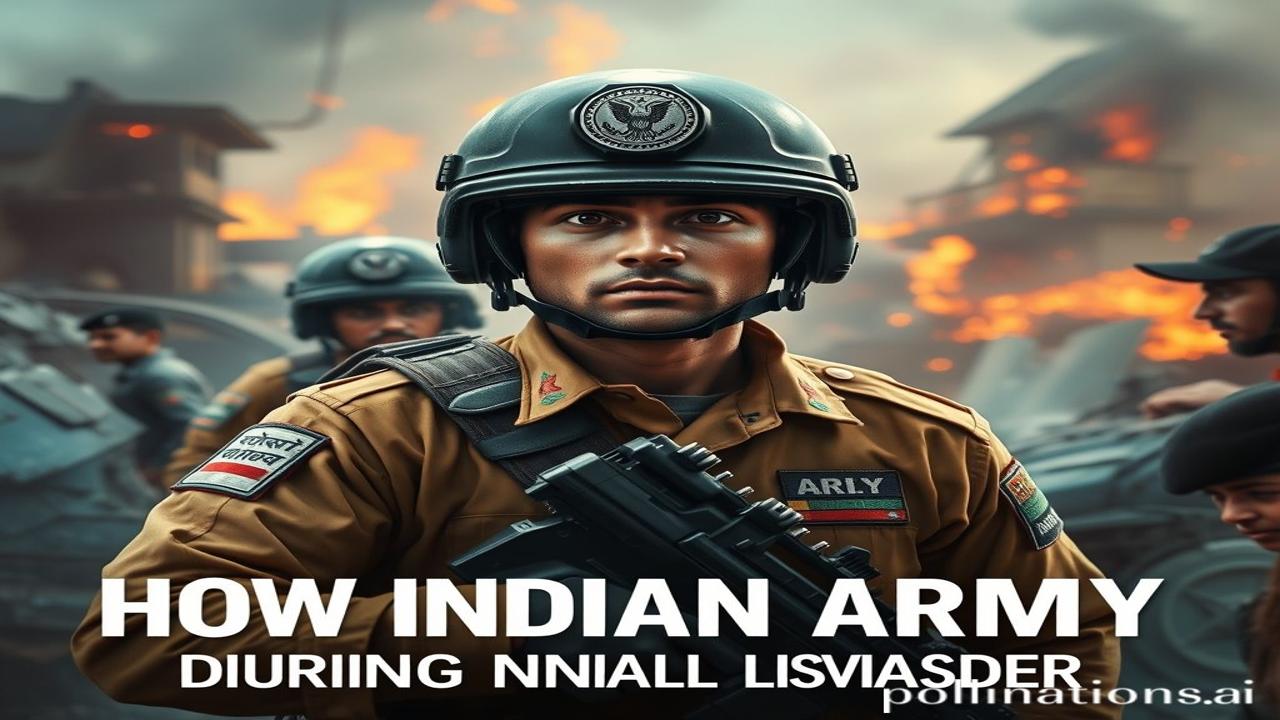Desh ki Dhaal, Jan Jan ki Madad: How the Indian Army Steps Up During Natural Disasters
Kabhi kabhi lagta hai, jaise humari dharti maa hi ro rahi hai. Clouds fat jate hain, nadiyan ufan pe aati hain, aur logon ke sapne ret ki tarah bikhar jate hain. Aise waqt mein, umeed ki ek kiran aati hai – khaki vardi mein, hath mein jaan bachane ki kshamata liye. Woh hai humari Bharatiya Sena, the Indian Army.
A Silent Promise: The Indian Army’s Role in Disaster Relief
What exactly is the Indian Army’s role during a natural disaster? It’s more than just rescue. It’s about rebuilding lives, restoring hope, and reminding a broken community that they are not alone. The Army’s involvement isn’t written in bold headlines but in the silent promise of “nation first.”
When and where did this tradition begin? It’s difficult to pinpoint an exact date. Think back to the devastating floods of Bengal in the 1940s, the Assam earthquakes, or even the more recent Uttarakhand floods. The Indian Army has consistently been at the forefront, offering unwavering support. While the National Disaster Management Authority (NDMA) is the apex body, the Army brings unparalleled logistical capabilities, engineering expertise, and disciplined manpower to the table.
Why is it important? Because in moments of chaos, organization is paramount. The Army’s structured approach, ability to deploy quickly, and experience working in challenging environments makes them uniquely equipped to handle the aftermath of a natural disaster. It is a testament to their commitment to safeguarding the nation, not just from external threats, but also from the wrath of nature.
Zameeni Sach: Stories from the Frontlines
Imagine this: It’s 2013, Uttarakhand. The skies are weeping, and the Alaknanda rages like a wounded beast. Homes have vanished, roads are washed away, and thousands are stranded. Soldiers, many of whom haven’t seen their families in months, are wading through waist-deep water, carrying the old, the young, and the helpless on their backs.
“Beta, himmat mat haaro. Hum hain,” a soldier whispers to a shivering child, sharing a meager biscuit. This wasn’t a scripted movie scene; it was reality.
Think of the engineers who worked tirelessly, day and night, to rebuild bridges and roads, often with limited resources. Picture the medical teams providing aid in makeshift hospitals, battling exhaustion and emotional fatigue. These are the stories of ordinary men and women, doing extraordinary things.
Ma Sita Devi, an old woman from a remote village, recalls, “Sena ke jawaanon ne meri jaan bachayi. Bhagwan unko khush rakhe.” She may not know the names of the soldiers who helped her, but she remembers their kindness, their unwavering resolve.
Dharohar aur Pehchan: Echoes in Modern India
Today, the Indian Army’s disaster relief operations are a defining aspect of Bharatiyata. It’s a part of our collective consciousness. When we see floods, earthquakes, or cyclones on the news, we know, somewhere in our hearts, that the Army will be there.
This isn’t just about physical assistance; it’s about psychological support. The sight of the Army uniform provides reassurance and a sense of security. It reinforces the idea that even in the face of overwhelming adversity, the nation cares. It’s about upholding the value of “seva” (service) – a core tenet of Indian culture.
You can see this ethos reflected in disaster management training programs across the country, in the countless individuals who volunteer to help those affected by tragedy, and in the unwavering belief that together, we can overcome any challenge.
Majedar Tathya ya Bhram-Bhanjak: Myths Debunked!
Log samajhte hain ki the Army is only called in as a last resort. But, the asli sach yeh hai ki the Army is often deployed proactively, especially in areas prone to natural disasters. Pre-emptive deployment allows them to be better prepared and respond more effectively.
Another misconception is that the Army only provides immediate relief. While immediate rescue and aid are crucial, the Army also contributes to long-term rehabilitation efforts, assisting in rebuilding infrastructure and restoring livelihoods.
Drishya aur Bhavnaein: A Sensory Experience
Imagine the smell of damp earth and diesel as helicopters churn overhead. The feel of cold rain on your skin mixed with the sweat of hard work. The sound of rushing water juxtaposed with the comforting murmur of soldiers coordinating rescue efforts. The sight of destruction mingled with the determination in the eyes of those rebuilding their lives. This is the sensory landscape of an Army disaster relief operation.
You see, the air crackles with a mix of fear and hope. The temple bells, though often silent due to the disaster, represent a resilience that will eventually chime again. The taste of that simple biscuit shared by the soldier becomes a symbol of humanity in the face of overwhelming loss.
Antim Vichar ya Uddharan: A Closing Insight
“Apadā kāla meñ, sahyoga hi śakti hai.” (In times of disaster, cooperation is strength.)
The Indian Army’s role in disaster relief is a powerful reminder that true strength lies not just in military might, but also in compassion, resilience, and the unwavering commitment to serve humanity. It is a testament to the spirit of India, a nation that stands united, ready to face any challenge, together. It’s not just about following orders; it’s about answering the call of duty to protect every single citizen, come what may. This is the essence of being Bharatiya, the soul of India.
